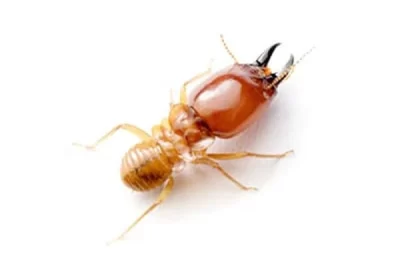Latin Name: Reticulitermes spp.

Subterranean termites are one of the most dangerous termite species in the world. They are usually found in distinctive tunnels, often called mud tubes, to protect themselves from open air and store food sources. They eat wood with their saw-toothed jaws, which helps them bite small fragments one piece at a time. As they continue to eat, subterranean termites threaten homeowners across the country from every state in the U.S except Alaska. They are popular in subtropical and humid regions like Southern California and Florida.
They have three different castes with varying physical features – the workers, soldiers, and reproductive. The reproductive are usually the alates, king, and queen, and they are all essential to the growth of that colony. Usually, the queen is bigger than the king. The alates, also called swarmers, have long, black bodies, slightly milk-colored wings, and translucent bodies. They are usually about ¼ to ½ inch in length, and their wings barely have any visible hairs. Unlike the swarmers, the workers and soldiers are wingless.
The workers are ¼ inch with cream bodies and small jaws to chew wood and move materials. You can differentiate their soldiers by their large mandibles, rectangular heads, and flat bodies.
Although they also have a cream body similar to the workers, they usually have a dark and brownish head. You can also differentiate them by the appearance of the wood they eat. Subterranean termites are found in underground nests or within the accumulation of soil or mud.
Generally, they are creamy white, dark brown, or black in color. Also, they have six legs and are mostly long, narrow, and oval. They have antennae and are about 1/8 inch long.
Subterranean termites live within softwood or damaged wood that seems layered. Just like their name suggests, they stay below the ground. When you see them above the ground, it is only because of sufficient moisture conditions available there. You will also find them in-between cracks in concrete walls and foundations of the house.
You will also find them exist almost everywhere in the United States but are scarce in cold states. They also appear in large numbers in warm and southern areas of the United States except for Alaska. They are popular in subtropical and humid south between regions like Southern California and Florida.
They swarm during spring, especially after a considerable amount of rain has just fallen.
They feed on dirt, including wood and other cellulose material. They prefer to feed on decayed wood. Digestion usually begins before the termite even starts to take the first bite.
Subterranean termites consume wood at the same rate. Still, other factors could make them eat faster and more voraciously, like the environment, the size of the termites (larger termites eat more wood), and the number of termites (the larger the colonies, the more wood they will eat).
They come out well during seasons like spring, fall, or summer. They are sometimes mistaken for flying ants. However, you can differentiate them by their straight antennae and wings. Another common sign is the presence of mud tubes. Mud tubes are long tunnels of wood and soil constructed by termites as they travel through the ground. Other signs are the sound they make when they tap or blister through wooden structures in the home. Also, after mating, swarmers are known to shed their wings and leave them in piles like fish scales. You will find these piles on the windowsills of your home.
Subterranean termites are one of the most dangerous species in the termite family. They can cause critical damage to the building structure, which can eventually result in a total collapse. They also feed on books and other paper products. They also provide plant-based goods and other cellulose-based products.
Subterranean termites can cause severe damage to home property undetected for many years. Therefore, take measures to prevent their activities. Some of these measures are:
If you suspect these pests are in or around your home, give us a call for a Free Home Inspection!
